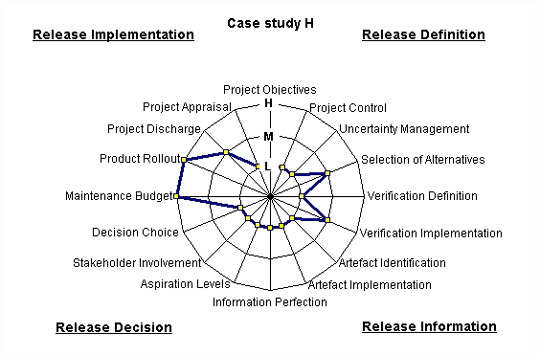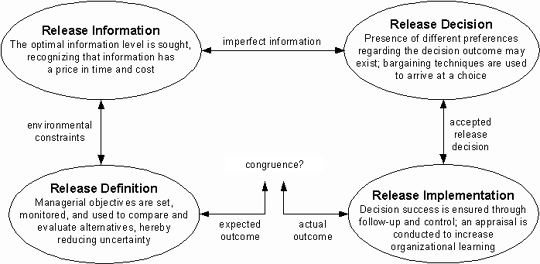
A Methodology to Support Software Release Decisions in Software Development
Hans Sassenburg, SE-CURE AG, www.se-cure.ch
Software is everywhere and has become a major worldwide industry. We find software embedded, for example, in watches, coffee makers, cars, televisions, airplanes, telephones, reservation systems, and medical equipment. Software not only pervades a multitude of products, but also is an important corporate asset, and demand is increasing. Yet software projects are characterized by schedule and budget overruns and the delivery of unreliable and difficult to maintain software products.
Despite an exponential increase in the demand for and dependence on software, many software manufacturers exhibit unpredictable behavior. It is sometimes difficult to determine, for example, a software product's release date, its features, the associated development costs, or the resulting product quality.
Without knowing the release date, a software manufacturer experiences difficulty planning product promotions, customer training, and maintenance support. Resource utilization across projects may become inefficient and difficult to manage when projects fail to meet schedules. Customers have difficulties planning for the introduction of new software into their organizations when a scheduled release date is missed.
The exponential growth of software suggests that end-users will be exposed to more defects if the software industry is not able to exponentially improve its defect potentials and removal efficiencies. Combined with increased competition and smaller market windows, software manufacturers likely will be exposed to higher levels of uncertainties when releasing software. The decision to release a software product will become an even more complex and important decision.
A Software Release Methodology Supporting Strategic Value
Existing methodologies, models, and standards reveal limited guidance for structuring software release decisions in a methodological way to support strategic value. A decision has strategic value when it has the potential for large prospective financial losses to a software manufacturer or its customers or end-users. Software release decisions often have strategic value due to high costs for reversing the decision. Prospective loss outcomes also may arise long after the decision has been made, for example, in cases where liability leads to lawsuits.
A software release decision can be seen from different perspectives:
- the reduced importance of a decision once it is made and implemented
- the control of the outcome of a decision by stakeholders not involved in its making
- the development of new situations and problems to command the attention of the decision-makers once the choice has been implemented
Research Findings
This research reviewed these different perspectives from both a theoretical and an empirical point of view by studying practical examples. The results helped to frame a proposed methodology, called release decision methodology, to address a software release decision from different perspectives. (See Appendix) The methodology, consisting of a coherent set of practices, combines insights from economics, software management, and social psychology disciplines.
Studies in three different organizations validated the methodology. One participating organization is a leading global financial services company that provides financial services and products to retail and business markets. Services include insurance, pensions, occupational health and safety, asset management, investments, leasing, real estate, venture capital, and mortgage finance.
The research examined a project in this organization's IT department, which develops custom systems for internal and external use. The initial estimate for the schedule was 10 months and for the pre-release cash outflows, Euro 15M. Budgets were reserved for the technical infrastructure and post-release cash outflows for maintenance and exploitation. During the first months, the project encountered several setbacks: technical problems surfaced and the development budget turned out to be too optimistic. Progress control was lacking, mainly through the absence of clearly-defined milestones or quality gates. These problems increased, and in November 2001, the project was re-defined. Both Senior Management and Marketing exerted pressure on the Product Development Team to release the product as soon as possible. However, the team was faced with an unstable product under test and had to use a veto several times to postpone a scheduled release date. When the product was released, uncertainty was high because many known problems were not resolved (although not considered critical), and the organization judged that continued testing would reveal more defects, including potentially critical ones, that could severely hamper the correct functioning and stability of the product.
After the product was released, a special task force assumed responsibility for temporarily performing corrective maintenance activities. This team needed more than a year to resolve the known and newly-detected defects. Despite the original requirement to develop a maintainable product, the organization decided in 2004 to start a pre-study toward a totally new product to replace this product because corrective maintenance and functional enhancements proved difficult and costly. In other words, the early release of the product saved the organization additional testing cost, but the post-release maintenance cost turned out to be significantly higher than expected. A retrospective review of this project using the software release methodology enabled this organization to assess the project from a release decision point of view.
Figure 1 illustrates how the organization scored on the identified practices in the methodology. Lack of a product development strategy (release definition) and lack of information as input to the decision-making process (release information) led to a poorly structured release decision-process without consensus among the stakeholders involved (release decision). Sufficient financial resources "saved" the organization on the short-term by patching the released software.

Figure 1: Radar Presentation of Case Study Results.
Based on these validation results in a practical setting, the software release methodology displayed a descriptive and a judgmental character, and it can therefore support understanding, analyzing, assessing, and improving the capability of software manufacturers in this problematic area, at least in the studied environments. Currently, ongoing research in software manufacturer environments is under way to study the effects of applying the methodology at the start of projects to proactively aim for release decision success.
Reference:
Leveson, N.G. "The Role of Software in Spacecraft Accidents." AIAA Journal of Spacecraft and Rockets, 41, 4, 2004.
Appendix: Release Decision Methodology

Figure 2: Release Decision Methodology.
In the release decision methodology framework, four areas in the software release decision-making process are distinguished, each addressing the process from different perspectives. A process area is defined as a cluster of related practices that, when performed collectively, achieve a set of goals considered important for establishing process capability in that area. Each process area consists of four relevant practices, describing "what" is to be accomplished but not "how." Through this approach, the descriptions of practices still offer the possibility for interpretation and customization to the external market environment and to internal strategic and functional characteristics of a software manufacturer organization.
Identified process areas are (see Figure 2):
More Agile Software Development and Project Management Knowledge
Click here to view the complete list of archived articles
This article was originally published in the Spring 2007 issue of Methods & Tools